Visualizing and Planning Cuts
Decisive thinking and clear planning are crucial in carpentry safety. Before turning that tool on, consider the safest approach. Are you sure your material is secured properly? Is the tool you're eyeing up the best for the job? Running through these questions pre-cut can save fingers and sanity.
Start by planting yourself firmly in front of your workbench. Envision the finished cut. Will you need clamps? Ensure they aren't in the tool's path. How will you approach the wood? Picture the move, whether a handsaw or miter saw, and decide on the best grip and stance. Visualizing isn't just about the end result; it's about anticipating trouble before it starts.
Table saws offer numerous ways to make cuts. Know the choice that fits your skill set and comfort level. Practicing the cut with the saw off can build muscle memory, helping you react seamlessly when the blade spins. A surprise mid-cut isn't the time to debate your next hand move.
Consider footwork too. Plan your moves around a tool, factoring in balance and reach. Keep a staggered stance—left foot forward, knees slightly bent—so if you stumble, you fall away from the blade. Clear your workspace of debris like cords and offcuts before anything spins. A slip on a cable can turn a routine cut into a near miss.
Prepping for emergencies also means having a quick shut-off strategy. Always know which hand is free to flick the off switch without losing control of the material. Some tools demand more dexterity than others, so plan accordingly, even down to which fingers are responsible for the power switch.
Each tool has quirks. Kickback, where wood launches unpredictably, is a common danger. Understand these risks. Using push sticks or blocks can manage kickback by keeping pressure down on the wood and keeping your hands a safe distance. Most importantly, never stand directly behind the board you're cutting; that's the bullseye during kickback.
Combining mental rehearsal with physical practice ensures a safer, more predictable workshop environment. By considering each move carefully and anticipating hazards, you can maintain confidence and work efficiently.
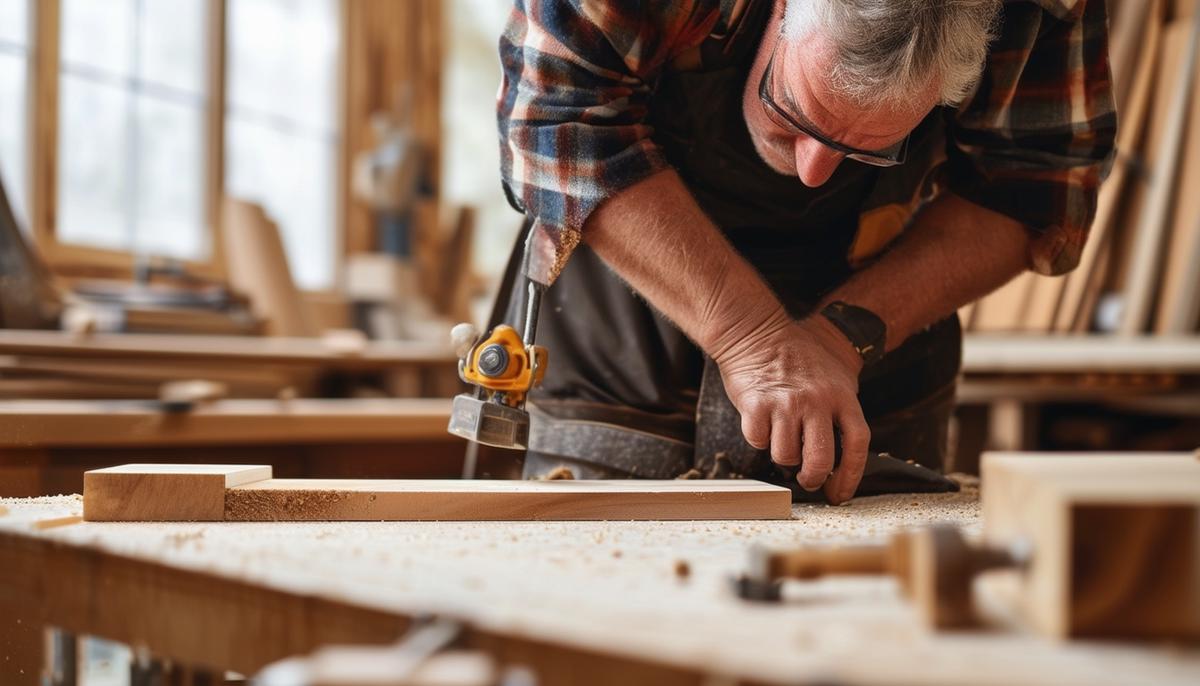
Understanding and Minimizing Kickback
Grasping and minimizing kickback is crucial to enjoying a safe woodworking experience. Kickback can be frightening and dangerous—a projectile flying back at high speeds, potentially causing serious injury. Knowing the causes and learning to prevent it can make a significant difference.
On a table saw, kickback often happens when the blade catches the wood mid-cut, pulling it toward the operator. Misaligned fences, warped wood, and incorrect feed pressure exacerbate this risk. Always ensure the wood being cut is properly milled and flat.
To counter these dangers, adopt key safety strategies. Firstly, the importance of using push blocks or sticks can't be overstressed. They help maintain downward pressure, guiding the wood safely through the cut while keeping your hands away from the blade. Push sticks are life-savers, especially for narrower cuts.
Keeping your wood properly secured, whether clamped to a table or held by stop blocks, also makes a critical difference. Loose or improperly secured pieces can easily become missiles. Before you start, ensure all clamps and securing devices are firm.
Standing out of the line of fire is another vital tactic. Never position yourself directly behind the cut. Instead, stand to the side, out of the direct path a board might travel if kicked back. This stance keeps you safer and allows you to operate the machine more relaxed.
Visualization and planning play a role. Imagine the worst-case scenario: where will the piece go if kicked back? Adjust your stance and plan your escape routes before any cut.
Kickback isn't entirely avoidable, but understanding its causes and implementing preventive strategies make it much less likely. Effective prevention starts with forethought—visualize potential problems and address them before they arise. This proactive approach fosters a safer, more controlled experience, allowing you to focus on the craft rather than hazards.
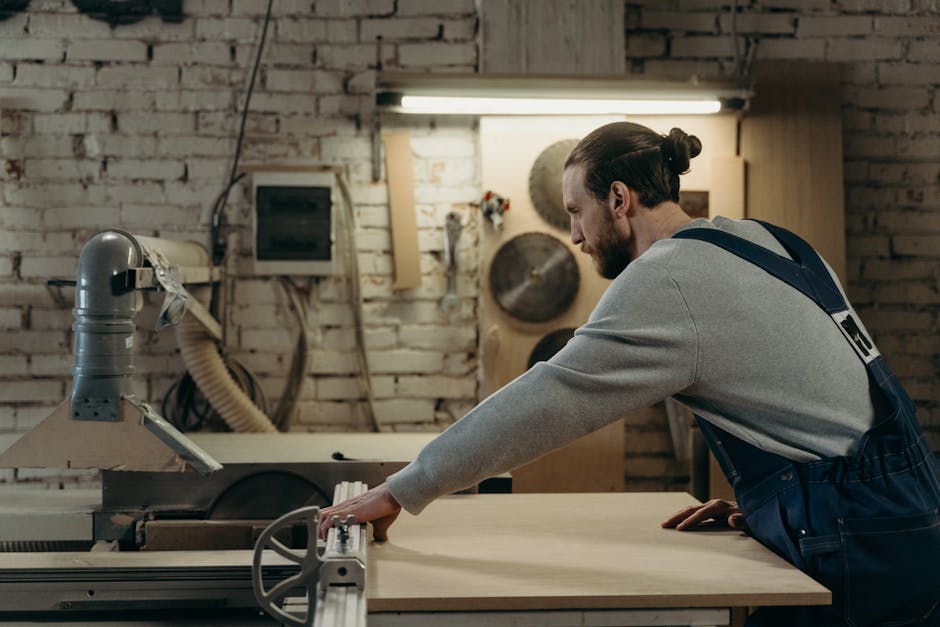
Knowing Emergency Power Off Procedures
Sometimes things go wrong, and knowing how to quickly and safely power off your tools can prevent serious injuries. Familiarize yourself with the power-off procedures for each tool and practice them until they become muscle memory.
Each tool may have a different method to stop it quickly. On some saws, you can use your thigh to bump off the power switch without letting go of the workpiece, leaving your hands free to stabilize it. This is important because cutting power immediately can prevent more significant mishaps when a piece gets jammed or starts to kick back.
For hand-operated tools like a handheld router, know which hand will operate the switch and which stabilizes. Practice repeatedly with the tool off, so it becomes second nature when reacting.
Consider your stance and position when working with tools, ensuring you can reach the power switch without fumbling or repositioning. Keep your workspace clear for easy and safe access to power switches.
Additionally, have a clear mental plan for an emergency. Practice procedures, even without turning tools on, to help actions become routine, enabling you to act swiftly and instinctively.
Never hesitate to power off if something doesn't feel right. If the tool sounds different, if the wood begins to bind, or if you're losing control, stop immediately. By prioritizing these power-off practices, you're not just protecting yourself—you're ensuring a smoother, more confident process.

Maintaining a Safe Workshop Environment
Keeping your workshop clean and hazard-free is crucial for safety. Regularly check for and remove trip hazards like cords and offcuts, ensure the floor is clean and dry, and store tools properly. A tidy workspace enhances safety but also boosts efficiency and focus.
Establish a routine for cleanliness. Return tools to their designated places after each use to prevent clutter and make it easier to locate tools when needed. Shelves, pegboards, and drawers can help keep everything organized.
Regularly inspect the floor for trip hazards, including offcuts and sawdust. Sweep or vacuum up dust and debris after each project to maintain a clean space and reduce the risks of slips and falls. Additionally, use non-slip mats around heavy machinery and frequently trafficked areas to enhance grip and stability.
Secure cords with organizers or hooks along the walls to keep them off the floor and reduce the risk of tripping. For mobile equipment, use retractable cable reels or strategically placed power outlets to avoid stretching cords across walkways.
Store materials properly too. Keep long boards or metal rods vertically in designated racks or storage systems to prevent tripping hazards. Store smaller materials like screws and nails in labeled containers.
Lighting plays a pivotal role. Ensure work areas are well-lit to avoid mistakes and prevent accidents. Task lights for detailed work can cut down on eye strain and improve accuracy.
Implementing a clean-as-you-go policy keeps the workspace tidy and clears your mind to focus on woodworking rather than dodging hazards. A clutter-free space fosters a more productive and enjoyable working environment.
Regular maintenance checks on your tools contribute to a safer environment as well. Ensure blades are sharp and machinery is well-oiled and functioning correctly. Dull blades cause kickback and erratic cuts, posing risks. Routine inspections and proper maintenance extend equipment lifespan and keep you working safely.
Having a specific place for everything prevents last-minute chaos. Knowing exactly where your chisels or wood glue is saves time and energy, minimizing the frantic, dangerous rush that often precedes a mistake.
Maintaining a safe workshop is about preserving order as much as physical safety. A well-organized and clean workspace nurtures better focus, higher efficiency, and greater satisfaction in your woodworking journey. It's an investment in creating an environment where creativity and safety thrive hand in hand.
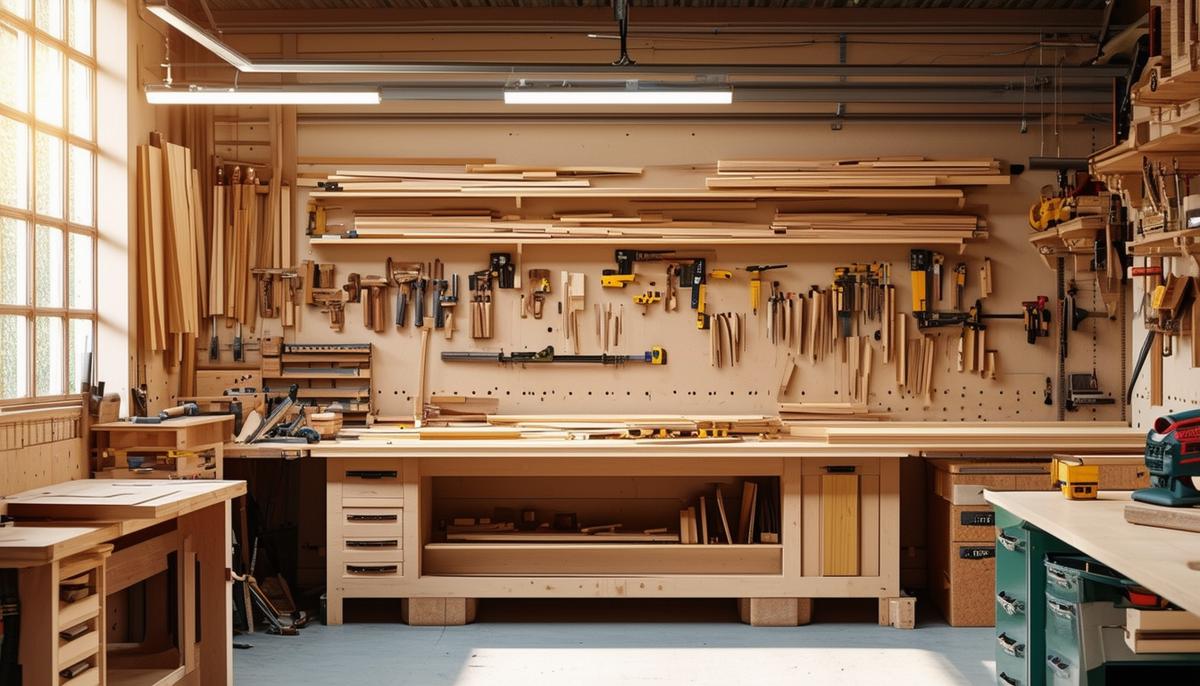
Footwork and Balance
Proper footwork and maintaining balance can significantly prevent accidents in your workshop. Stand with a staggered stance, placing one foot slightly ahead of the other, and keep both knees slightly bent. This posture naturally lowers your center of gravity, making you more stable and less likely to topple forward if something unexpected happens. This stance is crucial for comfort and a fundamental part of your safety protocol, allowing you to react more quickly and effectively if you need to step back or shift your balance suddenly.
Distributed weight plays a critical role in maintaining control. Leaning too much weight onto your hands can make you less stable and more prone to losing your balance. Think of your weight distribution as a foundational aspect that keeps you grounded and in control. Your legs and core provide essential support that ensures steady, deliberate movements.
Avoid over-reaching at all costs. Always move around the tool rather than lean over it. This way, you maintain your equilibrium and keep yourself a safe distance from the blades and moving parts.
Practicing and mastering your movements will build muscle memory, allowing you to execute tasks with confidence and precision. Visualizing how you will move is also vital. Before engaging the tool, mentally map out your steps—where you will stand, how you'll shift your weight, and which hand will guide the wood through the cut. This mental rehearsal preps your body for the task, making your movements more intuitive and less prone to error.
Keeping your workspace clear enhances your ability to move safely. By ensuring your pathway is free of obstacles, you create an environment where you can focus fully on maintaining balance and executing perfect movements.
Lastly, ensure the tools themselves are positioned to facilitate proper footwork. Adjust saw heights, ensure workbenches are not too cluttered, and arrange power cords out of your way. Every step you take to optimize your workspace contributes to better footwork and safer practice.
By adopting these habits, you reinforce a proactive approach to woodworking safety. Knowing how to stand correctly, distribute weight evenly, and avoid over-reaching sets the foundation for a safer, more controlled woodworking experience. These strategies enhance your overall woodworking skill, making every project smoother and more enjoyable.
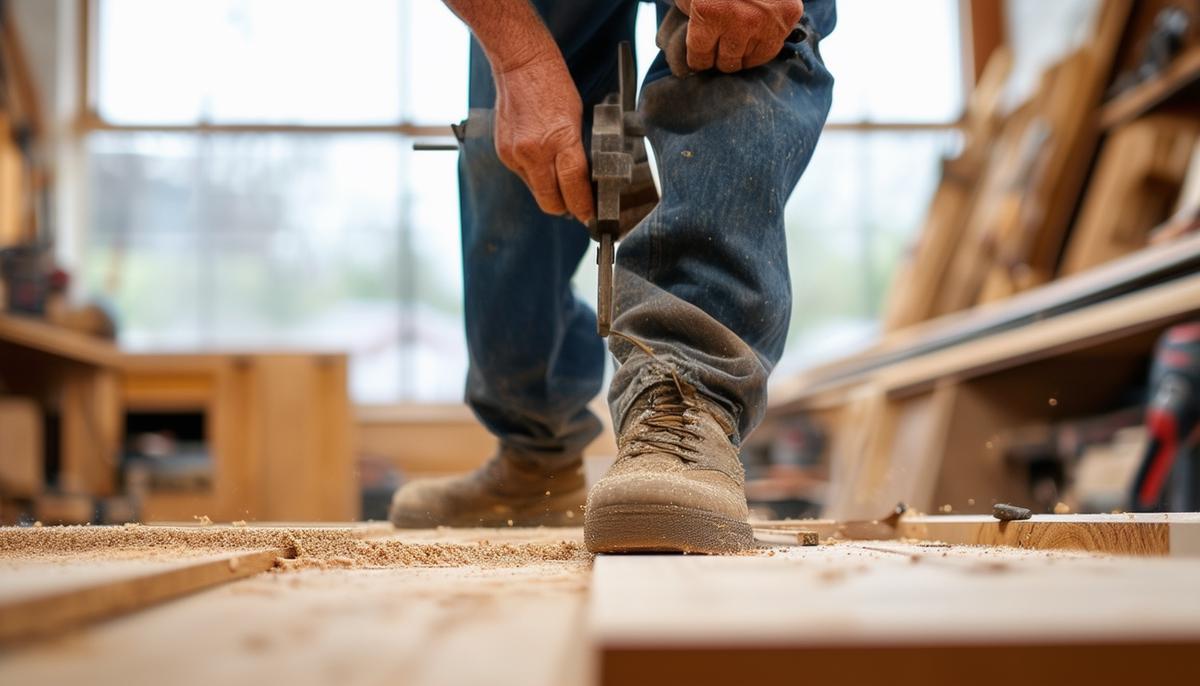
Consistent Processes for Each Tool
Establishing and adhering to a consistent workflow for each tool in your woodworking arsenal is paramount. This might seem tedious at first, but turning each step into a habit—from setup to cleanup—can dramatically minimize errors and enhance safety.
Start by familiarizing yourself with the specific setup procedures for each tool. Before turning on any machine, make a habit of checking that all safety guards are in place and functioning correctly. Verify that the work area is prepared, with adequate lighting and clear space for movement.
Calibration is crucial. Each tool has unique needs that require adjustments, such as blade height, fence alignment, bit height, and stability checks. Consistently performing these setup steps ensures your tools function at their best, reducing the risk of inaccuracies and malfunctions.
Developing a repetitive, systematic approach boosts efficiency and safety. For example, when using the table saw, have your push sticks and safety equipment within reach, measure and mark workpieces consistently, adjust settings, and execute the cut while maintaining a safe posture and using push blocks. This rhythm helps you maintain control and be keenly aware of the tool's behavior, spotting irregularities early.
Once the work is executed, the cleanup should be as systematic as the setup. Clearing sawdust, securing blades, and storing tools in designated spots ensure your workspace remains organized and free from hazards.
These routines build muscle memory, making tasks more instinctual and less prone to error. When you repeat the same processes consistently, anything out of the ordinary stands out, allowing you to troubleshoot and correct small issues before they result in larger, potentially dangerous problems.
Such discipline extends to consistent tool maintenance. Regularly checking for wear and tear, lubricating moving parts, and replacing dull blades not only prolong the tool's life but also promote safer usage.
Incorporating these consistent, repetitive workflows into your routine enhances safety and craftsmanship quality. Deeply ingrained habits free up mental bandwidth, allowing you to focus more on the creative aspects rather than the mechanics of tool handling.

Understanding Your Tools
Gaining knowledge of your tools' intricacies is essential for safe and effective woodworking. Start by examining the manuals and watching instructional videos that demonstrate proper techniques, safety practices, and maintenance routines.
Hands-on guidance from experienced woodworkers can fast-track your learning curve. They can provide immediate feedback, correct any unsafe practices, and share personal tips and tricks.
Understanding your tools involves familiarizing yourself with their limitations and capabilities. Every tool has specific functions it's designed for, and pushing beyond those can lead to accidents or tool damage. Knowing when to use each tool ensures both safety and precision.
Regular practice with each tool is necessary to reinforce your knowledge. The more you use a tool, the more intuitive its operation becomes, reducing hesitation and increasing your control.
Spend time understanding adjustments and calibrations to foster safer use. Many tools require periodic adjustments to maintain accuracy, such as setting depth, aligning fences, or adjusting blade angles. Being proficient in these calibrations ensures precise cuts, reducing the risk of binding or kickback.
Proper maintenance is crucial. Regularly inspect parts for wear, keep blades and bits sharp, and lubricate moving components as needed. This attention to detail prevents malfunctions and keeps your tools running smoothly.
Lastly, stay updated on safety advancements and consider upgrading older tools if necessary. Modern tools often come with enhanced safety features.
The time invested in understanding your tools fully pays dividends in safety, efficiency, and the quality of your work. This comprehensive approach—combining reading, watching, learning from others, and practicing—ensures you're not just using your tools, but mastering them.
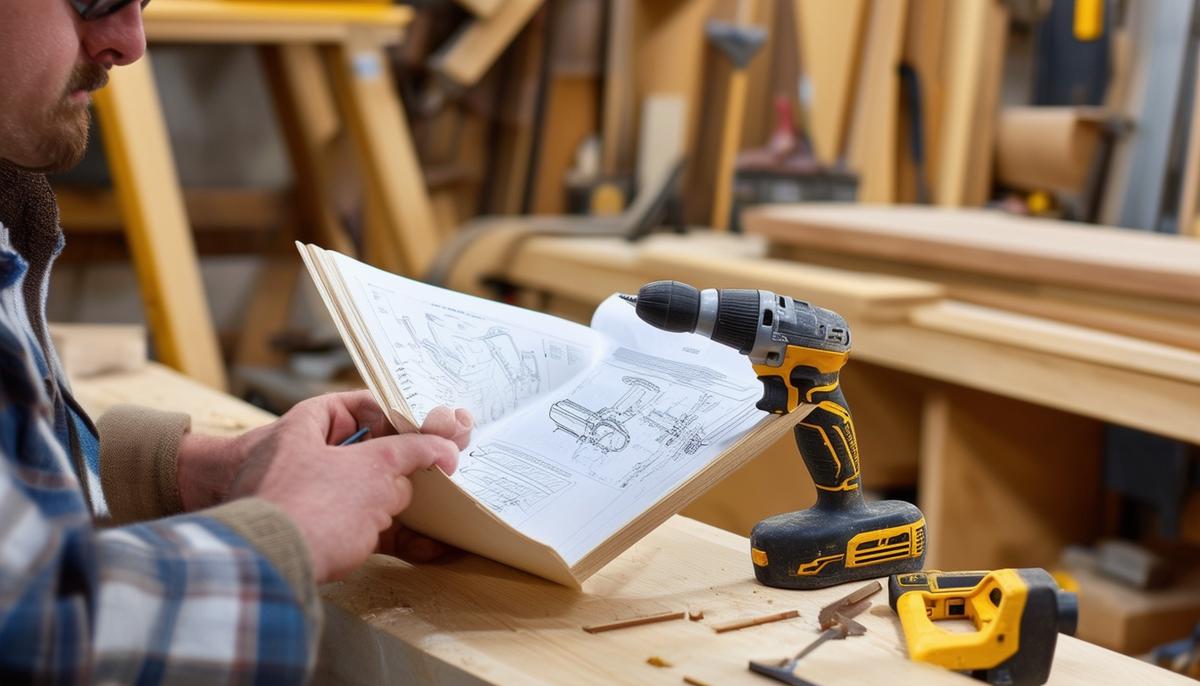
In woodworking, safety and precision go hand in hand. By consistently practicing thoughtful planning, maintaining a clean workspace, and understanding your tools deeply, you can create an environment where craftsmanship thrives. These habits not only protect you but also elevate the quality of your work. Remember, every step towards safer practices is a step towards more enjoyable and successful woodworking.
Leave a Reply